Welcome to a new Fox Tales feature that we’re calling “Five Questions.”
Each month we’ll ask publishing innovators and executives for their perspectives on their businesses, their markets and on the media industry more broadly. These frontline leaders have experience and insights in advertising and publishing operations that can help their peers as they develop strategies and manage their teams. This month, in our inaugural column, we catch up with John McIlquham, CEO of NPT Publishing Group, the Morris Plains, New Jersey, owner of the NonProfit Times and other brands. The transcript is lightly edited for brevity and clarity. Read on.

John McIlquham.
Fox Tales: How have the past 24 months changed how you do business?
John McIlquham: It has impacted us in a good way because it forced us to evaluate our cost structure regarding rents and other expenses. Some of it we eliminated, and it saved us money. But reaching people with our magazine when they are not in the office, making sure people were still getting it, that was a challenge initially. But we learned that they were. Mail gets forwarded. We didn’t see any significant downdraft at all from that. As a matter of fact, it bolstered our digital, because people get enewsletters and reach websites regardless of where they are.
We believe, though, that eventually the momentum for digital is going to stabilize. So it has to continuously be more engaging. And you can do more with it. Animate, illustrate, abstract it. I think there’s going to be a stabilization and a hybrid approach with print.
The pandemic accelerated this trend. You have to track subscribers better and target them for the advertisers’ benefit.
Q: How has your team adapted to cancellations of events and/or hybrid models?
A: The cancellation of in-person events didn’t really impact us. The only sense that it hurt us is that we’re a relationship business. Not being able to see people in person somewhat stunted that. Otherwise, the fact that the events didn’t happen didn’t affect us financially because our message to marketers was that we could still get their messages out to the market. What it did for us is to reengage advertisers more cost efficiently than if they had exhibited.
That said, some of our conferences that went to an all-Zoom format never really worked out well. Couldn’t attract the numbers that an in person event would.
Advertising performance was actually enhanced with fewer events. But there was a lot of consolidation in the marketplace. The pandemic caused us to ask what we need to do for advertisers and subscriber benefits. Webinars. Podcasts. Anything to keep advertisers engaged with the marketplace—that was our main objective.
Q: Which of the pivots that came over the past 24 months resulted in permanent changes?
A: Having been on this earth as long as I have, I’ve found nothing stays the same. We were able to reduce our costs for rent and infrastructure, and we found ways of creating new opportunities and that came through working with our vendors, who were the source of ideas for adaptation from their own customers.
We also were reminded that we can’t get too far ahead of where our subscribers are in terms of their ability to access information. When people are on older systems, you can’t get too far ahead of them.
Q: How has your sales team managed to navigate over that same period of time?
A: We have a robust sales operation in the sense that we are constantly prospecting and trying to bring people into the fold. The Fox folks have done a good job helping us get through the pandemic. Advertisers come and they go. The pandemic caused a consolidation, but it forced us to look for the next ways to serve the market.
Q: How is the rest of 2022 shaping up?
A: It’s shaping up well. It’s a month-to-month thing, but we just have to watch out what’s going on with the economy. It’s what advertisers are reacting to. Everyone seems to be fairly solid about this year. No one has come to us and said we can’t advertise. The outlook is pretty good.
